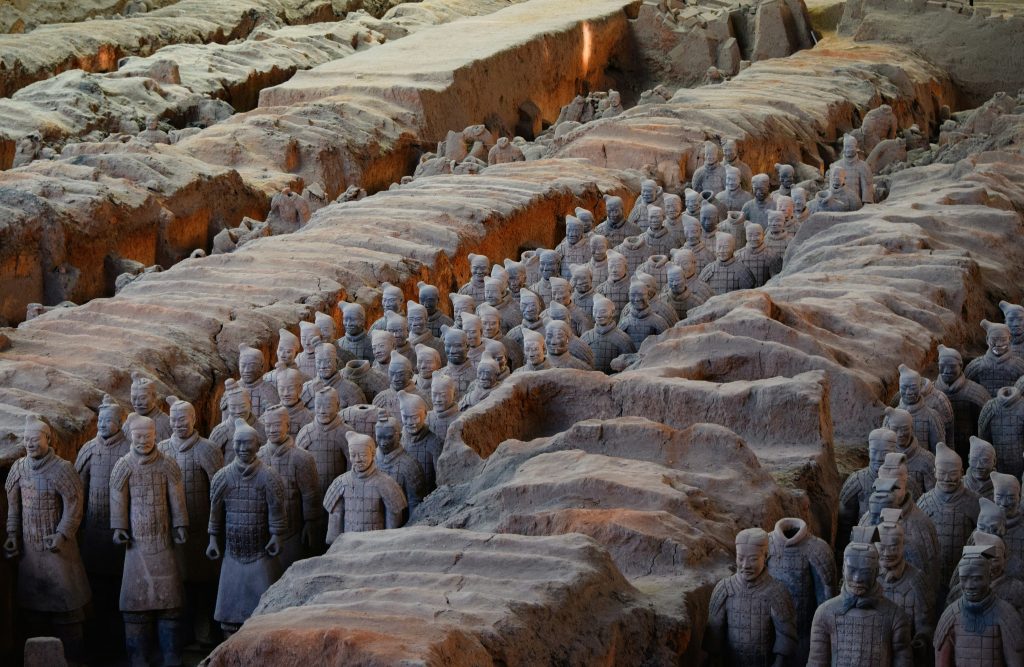
Xi’an Highlight-Xi’an is one of those places that feels like it’s been waiting for you—like it’s got stories to tell and secrets to share. Nestled in the heart of China, this city was once the starting point of the Silk Road and the seat of emperors, and you can still feel that history in the air. I’ve wandered its streets, tasted its flavors, and stood in awe of its ancient wonders, and I’m excited to take you along on this journey. Whether you’re here for the food, the sights, or just to soak in the atmosphere, Xi’an has a way of leaving its mark on you. Let’s dive in!
Where Is It? Geography and Population
Xi’an sits right in the middle of China, in the northwest part of the country. It’s the capital of Shaanxi Province and is surrounded by mountains, which give it a dramatic backdrop and a sense of being cradled by nature. The Wei River flows nearby, adding to the city’s charm. With over 12 million people calling it home, Xi’an is a bustling metropolis, but it doesn’t feel as frantic as some of China’s bigger cities. There’s a mix of old and new here—towering skyscrapers stand alongside ancient temples, and the streets are alive with the hum of daily life. Walking around, you’ll hear the local dialect, a melodic twist on Mandarin, and see faces from all over China and beyond, drawn to Xi’an’s rich history.
What’s the Weather Like?
Xi’an has a continental climate, which means it gets hot in the summer and cold in the winter. Summers (June to August) can sizzle, with temperatures climbing past 35°C (95°F)—it’s the kind of heat that makes you crave a shady spot and a cold drink. Winters (December to February) are chilly, often dipping below freezing, so you’ll want to bundle up. The best times to visit? Spring and autumn. Spring brings blooming flowers and mild days, while autumn offers crisp air and golden leaves—perfect for exploring the city’s outdoor sights without breaking a sweat or shivering.
Food That’ll Steal Your Heart
If you love food, Xi’an is a dream. The city’s cuisine is hearty, flavorful, and unlike anything you’ll find elsewhere in China. Here are a few dishes you’ve got to try:
- Biang Biang Noodles: These are wide, hand-pulled noodles that get their name from the sound the dough makes when it’s slapped against the table. Tossed in chili oil and topped with garlic and greens, they’re chewy, spicy, and addictive. I still remember my first bowl—messy, but worth every slurp.
- Roujiamo (Chinese Hamburger): Think of it as a Chinese-style sloppy joe. Shredded pork or beef stuffed into a crispy flatbread, seasoned with cumin and chili. It’s the ultimate street food, and I grabbed one every chance I got.
- Yangrou Paomo (Lamb Soup with Bread): This is a Xi’an specialty—chunks of unleavened bread soaked in a rich lamb broth, topped with tender lamb slices. The best part? You get to tear the bread yourself before it’s added to the soup. It’s a hands-on meal that warms you from the inside out.
For a true taste of Xi’an, head to the Muslim Quarter. It’s a maze of stalls and shops selling everything from spicy lamb skewers to sweet persimmon cakes. The energy there is electric—vendors calling out, the sizzle of grills, and the smell of spices in the air. It’s a feast for all your senses.
Sights You Can’t Miss
Xi’an is a treasure trove of history, and its attractions are world-class. Here’s where to start:
- The Terracotta Army: This is the big one. Thousands of life-sized clay soldiers, each with its own unique face, standing in formation to guard an emperor’s tomb. When I first saw them, I was speechless—it’s like stepping into a time machine. You can almost hear the echoes of the past.
- The City Wall: Xi’an’s ancient city wall is one of the best-preserved in China. You can walk or bike along the top (I recommend biking—it’s a blast) and get a bird’s-eye view of the city. The contrast between the old fortifications and the modern skyline is striking.
- The Big Wild Goose Pagoda: This towering Buddhist pagoda dates back to the Tang Dynasty. Climb to the top for a panoramic view, or just wander the gardens around it. At night, the pagoda lights up, and there’s a fountain show that’s pure magic.
For something off the beaten path, visit the Shaanxi History Museum. It’s packed with artifacts that tell the story of China’s dynasties—pottery, jade, and bronze pieces that are thousands of years old. It’s like a crash course in Chinese history, and it’s free!
A Culture That Dazzles
Xi’an’s culture is a blend of influences from its Silk Road days, when it was a melting pot of traders, scholars, and travelers from across Asia. You can see this mix in places like the Great Mosque, which looks like a traditional Chinese temple but is actually a place of worship for the city’s Muslim community. It’s a beautiful example of how cultures can blend and coexist.
The city is also known for its traditional crafts, like paper cutting and shadow puppetry. I picked up a few paper-cut bookmarks as souvenirs—they’re delicate and colorful, and each one tells a story. If you’re lucky, you might catch a shadow puppet show in a local theater. It’s a dying art, but the way the puppets dance behind the screen is mesmerizing.
Catch a Performance
Speaking of performances, the Tang Dynasty Show is a must-see. It’s a dazzling display of music, dance, and costumes from one of China’s most prosperous eras. The performers glide across the stage in flowing silk robes, and the music—played on ancient instruments—feels like it’s pulling you back in time. I watched it with a group of friends, and we were all grinning like kids by the end–
For something more low-key, check out a traditional music performance at the Bell Tower. The tower itself is a landmark, and the nightly concerts there feature guzheng (a Chinese zither) and other classical instruments. It’s a peaceful way to end a day of exploring.
Getting Around Made Easy
Xi’an’s transportation is straightforward, especially with its growing metro system. The metro covers most of the main attractions, like the Bell Tower and the Terracotta Army (though you’ll need to transfer to a bus for the last leg). It’s cheap—fares start at 2 RMB (about 30 cents USD)—and the signs are in English, so you won’t get lost.
Buses are another option and go everywhere, but they can be tricky if you don’t speak Chinese. Taxis are affordable and easy to find, especially through apps like Didi (China’s version of Uber). If you’re feeling adventurous, rent a bike to explore the city wall or the quieter streets around the university district. Just watch out for traffic—Xi’an drivers can be a bit… enthusiastic.
Why You’ll Love Xi’an
Xi’an is a city that surprises you. It’s got the weight of history—ancient warriors, towering pagodas, and city walls that have stood for centuries—but it’s also got a youthful energy, with students, artists, and entrepreneurs bringing new life to its streets. Whether you’re slurping noodles in a back alley or standing in front of a clay army, Xi’an makes you feel connected to something bigger. So pack your curiosity, bring your appetite, and get ready to fall in love with one of China’s most incredible cities. You’ll leave with stories to tell and memories that stick.
